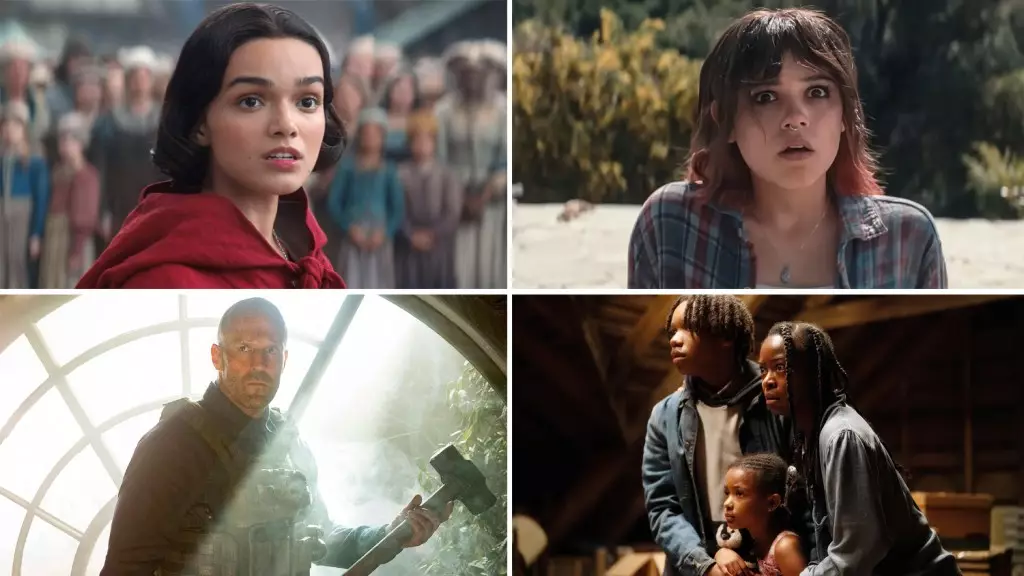As moviegoers flock to theaters during the spring break weekend, they are met with an uninspired lineup of film offerings. Five—yes, five—wide releases are hitting the big screens this weekend, but don’t let the numbers mislead you: this is not the bustling cinematic feast that audiences crave. Instead, it represents a significant decline in creativity and execution from an industry that once dazzled us with its storytelling prowess. Even Disney’s live-action rendition of “Snow White” struggles to hold its ground, projected to earn no more than $20 million in its second weekend. This isn’t just disappointing; it’s symptomatic of a greater malaise infecting Hollywood.
Disney’s Dwindling Magic
“Snow White,” the quintessential fairy tale that has transformed and enchanted audiences for nearly a century, now sits under a heavy cloud of mediocrity. Its projected 53% drop-off is hardly a surprise, especially when we consider the cultural criticisms surrounding the film’s inconsistent messaging amidst today’s values. Disney’s attempt to breathe life into its classic characters through live-action isn’t just faltering; it’s becoming a tiresome formula. The excitement that once accompanied Disney releases now feels like a distant memory, overshadowed by an avalanche of cynicism about the film’s lack of originality and innovative storytelling.
While the princess remains the “fairest” due to high-profile IMAX screenings, one can’t help but wonder: Are audiences truly captivated, or is their attendance an act of nostalgia seasoned with resignation? We can anticipate Rachel Zegler capitalizing on a fleeting moment of glory, but can we genuinely celebrate a “hit” that seems more like a compromise?
Sophomore Struggles of New Releases
This weekend also sees the release of “Death of a Unicorn,” starring Paul Rudd and Jenna Ortega—a film that could have been a thrilling escape but instead rings hollow, with projections barely hitting the $7 million mark. The narrative of a father and daughter encountering a unicorn feels uninspired for today’s audience members who are hungry for depth and originality. The juxtaposition of two horror movies competing for female viewers under 25 simply adds to the confusion. Is Hollywood intent on continuing its lethargic cycle of derivative storytelling?
With “The Woman in the Yard” adding salt to the wound, it’s evident that the horror genre is also regressing into tired clichés. While Blumhouse has found a niche in thrillers, it leads us to question whether audiences are forced to watch these films out of desperation for entertainment or genuine interest.
Hope on the Horizon with Established Directors
In the shifting sands of this weekend’s offerings, there may be glimmers of redemption. David Ayer’s “A Working Man” starring Jason Statham holds potential for a more considerable, if modest, success range of $10 to $12 million at the box office. With an approval rating of 68%, it’s clear that not all is lost. It’s refreshing to see Ayer working with Statham again, especially after their previous venture together delivered noteworthy profit margins. Despite its chances being marred by the overall bleak landscape of new releases, audiences might just find solace in the partnership of established filmmakers and actors.
Both Ayer and Statham possess a track record that could stimulate audience interest, yet it’s disheartening to witness how easily a well-crafted narrative can get lost among an avalanche of subpar releases. Is it too much to demand more from our filmmakers?
The Cultural Disconnect
Meanwhile, audiences will also be treated to “The Penguin Lesson,” which tells the story of an Englishman grappling with life in a divided Argentina while rescuing a penguin. The narrative, though heartwarming, appears like a grainy snapshot amidst the vibrant tapestries traditionally woven by cinema. Experiencing “The Penguin Lesson” may offer a temporary reprieve, but it highlights how disconnected current cinematic narratives are from the global events that shape our lives and perceptions.
Such diluted content can’t effectively engage an audience yearning for storytelling that resonates with the complexity of contemporary society. Ultimately, one must ask: Are we witnessing an industry so entrenched in itself that it overlooks the needs and wants of its audience?
The box office may reflect a financial reality for studios, but it undeniably mirrors a broader concern about the creative stagnation plaguing Hollywood during what should be a golden age for storytelling. Is it too late to revive the magic, or will we continue down a rabbit hole of uninspired reinterpretations and forgettable narratives?

